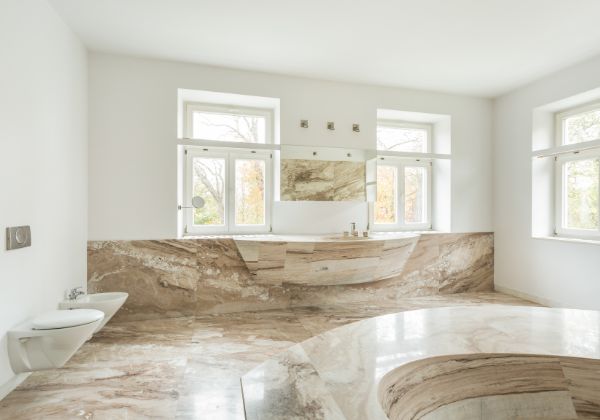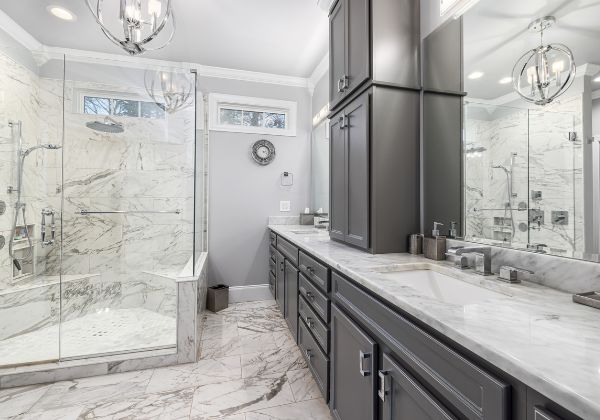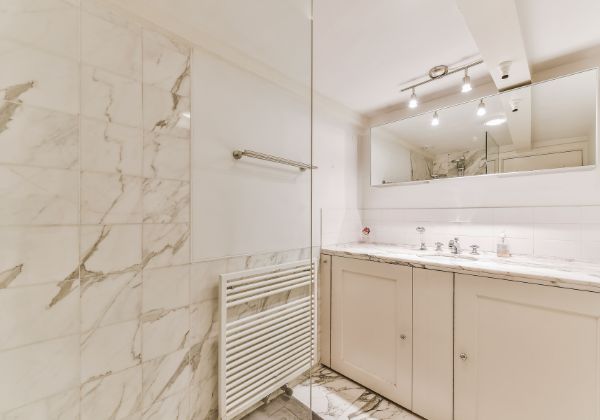How to Choose the Right Bathroom Remodel Materials for Durability and Style
A bathroom remodel is one of the most significant home improvement projects you can undertake. It’s not just about aesthetics—it’s about creating a functional, durable space that meets your needs and stands the test of time. Selecting the right materials for your bathroom remodel plays a vital role in achieving this. From countertops to flooring, each material affects the room’s look, feel, and performance. But with so many options available, how do you make the right choice? This guide will walk you through the critical factors to consider when choosing bathroom remodel materials.

1. Assess Your Needs and Budget
Before diving into the world of bathroom materials, it’s essential to assess your needs and set a realistic budget. Materials for your new bathroom remodel vary widely in cost, durability, and maintenance requirements. To make informed choices, start by determining your priorities. Do you need materials that are easy to clean, or are you more focused on features like style and luxury?
Defining Your Budget
The budget is the foundation of any renovation project. A well-planned budget ensures you don’t overspend while still getting the best materials for your bathroom. Begin by allocating funds to essential items like the bathroom floor, countertops, and bathroom fixtures like faucets and vanities.
When setting your budget, factor in the long-term costs of maintenance. While some materials, like ceramic tile or quartz countertops, are more expensive upfront, their durability and low upkeep make them cost-effective in the long run. On the other hand, affordable options like vinyl might save you money now but could require more frequent replacement.
Consider Durability and Maintenance
Not all bathroom materials are created equal. Some are resistant to moisture and stains, while others require regular upkeep. For instance, natural stone, such as marble, provides a luxurious look but can require sealing and careful maintenance to prevent staining. Durability is key, especially for high-traffic bathrooms where wear and tear are inevitable.

2. Flooring Options: Choose the Right Materials For Your Bathroom
When planning a bathroom remodel, your choice of flooring is crucial. The right bathroom floor can withstand moisture, resist wear, and elevate the overall design. Here’s a breakdown of popular flooring options.
a. Tile Flooring
Tile is a popular choice for bathroom floors due to its durability and design versatility. Both ceramic and porcelain tiles are available in various colors, sizes, and patterns, allowing you to create a custom look that complements the theme of your bathroom.
Pros & Cons of Tile Flooring
Pros:
- Extremely durable and moisture-resistant.
- Available in various designs, colors, and sizes to match any bathroom design.
- Easy to clean and maintain, which is perfect for high-traffic bathrooms.
Cons:
- Can be cold and hard underfoot, making it uncomfortable without underfloor heating.
- Grout can stain or accumulate mold without regular cleaning.
b. Natural Stone Flooring
Natural stone tile, such as marble or slate, adds a touch of luxury to any bathroom space. The natural variations in the stone create a unique, elegant look that can't be replicated by other materials.
However, natural stone is porous and can be susceptible to stains if not properly sealed. Materials like marble may require more upkeep, as they can be scratched or etched by harsh cleaning products. Despite the upkeep, the luxurious look and feel of natural stone make it a preferred option for many homeowners looking to transform their bathroom.
c. Vinyl Flooring
Vinyl flooring is a cost-effective option, particularly for budget-conscious homeowners. Available in a wide range of styles, including options that mimic the look of tile or natural stone, vinyl is easy to install and maintain.
Vinyl is water-resistant and softer underfoot compared to tile, making it comfortable for everyday use. It's also a practical choice for rental properties or second bathrooms. However, vinyl may not have the same longevity as materials like porcelain or stone.

3. Countertops: Selecting the Right Fixtures and Materials For Your Vanity
Countertops are the centerpiece of a bathroom's vanity, combining both aesthetics and functionality. Pick materials that reflect your bathroom’s style while being resistant to moisture and wear.
a. Quartz and Granite
Quartz and granite are durable, scratch-resistant materials perfect for long-term use. Quartz countertops offer a non-porous surface, making them resistant to stains and easy to clean. Granite, while porous, can be sealed to protect against stains. Both materials come in a wide range of colors, allowing you to match them to the theme of your bathroom.
b. Solid Surface Materials
Solid surface materials like Corian are an affordable alternative to natural stone. These surfaces mimic the look of stone without the higher price tag, making them a popular choice for homeowners on a budget. Solid surface materials are also easy to maintain and repair, which is why they remain a practical option for any bath remodel.
c. Eco-Friendly Choices
For homeowners looking for sustainable options, eco-friendly countertop materials like bamboo or recycled glass offer an excellent balance of style and environmental consciousness. These materials add a unique touch to bathroom design while reducing the environmental impact of your remodel.

4. Wall Materials: Choose Materials That Are Moisture-Resistant and Stylish
Choosing the right wall materials is critical, as bathroom walls are constantly exposed to moisture. Opt for materials that are moisture-resistant and easy to clean while still allowing for personal style.
a. Tile Backsplashes
Tile backsplashes offer versatility in design and easy maintenance. Ceramic tile, mosaic tile, and porcelain tile are popular choices, allowing homeowners to create unique patterns and color schemes. Backsplashes can also serve as an accent feature, drawing attention to key areas of the bathroom.
b. Paints & Wall Panels
For a low-cost, easy-maintenance option, waterproof paint or wall panels are great choices. High-quality paints designed specifically for bathrooms resist moisture and prevent mold. Wall panels are also a practical solution to get your bathroom organized, offering a sleek, modern look with minimal maintenance.
FAQs
What is the best flooring option for a bathroom?
Porcelain tile is widely considered the most durable flooring option of the different materials available for bathrooms. Its water-resistant properties make it ideal for wet environments, while its strength and hardness ensure it can withstand daily wear and tear. Additionally, porcelain comes in many styles, allowing homeowners to achieve both durability and design versatility.
How do I choose the right countertop material for a bathroom?
To choose the best countertop material, evaluate factors like durability, maintenance, and style. Materials like quartz and granite offer long-lasting durability, resistance to scratches, and a variety of styles, while solid surface materials can provide more affordable, low-maintenance alternatives that still mimic the look of natural stone.
How do I choose the best materials for my next bathroom remodel?
Assess your needs, budget, design preferences, and plan for your bathroom. Focus on selecting moisture-resistant materials and finishes that match your aesthetic. Budget also plays a significant role—higher-end materials like natural stone may offer luxury, while alternatives like vinyl provide affordable practicality without sacrificing functionality.
Can I install bathroom materials like flooring and countertops myself?
Yes, certain materials are DIY-friendly, such as vinyl flooring and solid surface countertops, which are easier to handle and install. However, for more complex materials like natural stone or quartz countertops, professional installation is often recommended to ensure proper fitting, prevent damage, and avoid costly mistakes.
How can I balance cost and quality when selecting the right materials for my dream bathroom?
Prioritize durability for high-traffic areas like floors and countertops, and consider more affordable options like vinyl or solid surface materials for areas where you can save without compromising quality.
Conclusion
Choosing the right materials for your bathroom remodel is essential to achieving a stylish and functional space. Whether you're selecting flooring, countertops, or wall materials, consider your budget, maintenance needs, and the overall design of your bathroom. For a hassle-free renovation experience, Remodel Your Home can connect you with local bathroom remodeling experts who will guide you every step of the way, ensuring you choose the right materials and stay within budget. Transform your bathroom into a dream space with expert advice and quality materials.

Remodel Your Home
We are a leader in the home improvement space with over 20 years of experience pairing homeowners with construction experts.
About Us